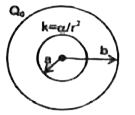What are the signs of ΔS for the system and for the surrounding in each of the following processes?
(a) Water boils in a teakettle on a hot stove.
(b) Ice in an ice cube tray, left an a table melts.
(c) A cup of coffee is reheated in a microwave oven.
The correct Answer is:(a) ΔSsys is positive ; ΔSsurr is negative; (b) ΔSsys is positive , ΔSsurr is negative; (c) ΔSsys is positive, ΔSsurr is negative.
(a)ΔSsys is positive , ΔSsurr is negative,
(b)ΔSsys is positive , ΔSsurr is negative,
(c)ΔSsys is positive , ΔSsurr is negative.
Topper's Solved these Questions
- THERMODYNAMICSBOOK - RESONANCECHAPTER - THERMODYNAMICSEXERCISE - exercise-3 Part-3 :(Subjective questions)Section A
1 Videos
- THERMODYNAMICSBOOK - RESONANCECHAPTER - THERMODYNAMICSEXERCISE - exercise-3 Part-3 :(Subjective questions)Section B
8 Videos
- THERMODYNAMICSBOOK - RESONANCECHAPTER - THERMODYNAMICSEXERCISE - exercise-3 Part-2 :(previous years)
11 Videos
- TEST SERIESBOOK - RESONANCECHAPTER - TEST SERIESEXERCISE - CHEMISTRY
50 Videos
Similar Questions
Name the mode of heat transfer in each of the following cases :following cases:
(a) In a vessel of boiling water.
(b) Heat energy teaching us from the sun.
(c) A vessel kept on a hot stove becomes hot.
(d) Warm breeze from the land flows towards the sea.
(e) A spoon kept in a hot tea cup becomes warm.
View SolutionClassify the following as open, closed, or isolated system.
a. A beaker containing as opne, boiling water.
b. A chemical recation taking place in an enclosed flask.
c. A cup of tea placed on a table.
d. Hot water placed in perfectly insulated closed container.
e. A thermos flask containing hot coffee.
View Solution
Knowledge Check
A student is carrying out distillation process in a lab. Water is boiling in the distillation flask. Water that is collected in the receiver flask is refrigerated and ice cubes are formed. Ice cubes are then kept outside the refrigerator and they started melting. Arrange the following phases of water in the ascending order of their total (PE + KE) energy considering that the mass of water remains the same.
(1) Water collected in the receiving flask.
(2) Water boiling in the distillation flask.
(3) Steam passing through the delivery tube.
(4) Ice cubes formed in the refrigerator.A4 3 2 1B4 1 2 3C3 4 2 1D4 1 3 2A student is carrying out distillation process in the lab. Water is boiling in the distillation flask. Water that is collected in the receiver flask is refrigerated and ice cubes are formed. Ice cubes are then kept outside the refrigerator and they started melating. Arrange the following phases of water in the ascending order of their total (P.E + K.E) energy considering that the mass of water remains the same.
(a) Water collected in the receiving flask.
(b) Water boiling in the distillation flask.
(c ) Steam passing through the delivery tube.
(d) Ice cubes formed in the refrigerator.AdcbaBdabcCcdbaDdacbAn ice ball of radius a and mass m is placed at 0∘C inside a thick hollow sphere of inner and outer radii a and b whose thermal conductivity varies as k=αr2, where α is a positive constant and r is the distance from centre. The temperature of surrounding is θ0 and latent heat of fusion for ice is Lf. Then , time required to completely melt the ice ball is (Neglect the contraction in volume when ice melts into water and any change in thermal resistance due to melting of ice of the system.)
 AmLfln(ba)4παθ0BmLf(b−a)2παθ0CmLf(b−a)παθ0DmLf(b−a)4παθ0
AmLfln(ba)4παθ0BmLf(b−a)2παθ0CmLf(b−a)παθ0DmLf(b−a)4παθ0
Ice cubes at 0∘C each of mass 200 g are dropped one after the other into 2 kg water at 30∘C in such a awayy that after the first one melts completely, the second one is dropped. If the heat energy required to melt 1 g of ice is 80 cal, determine the maximum number of ice ice cubes that can be dropped into the water such that no ice is left in the water without melting.
View SolutionIce cubes at 0∘C each of mass 200 g are dropped one after the other into 2 kg water at 30∘C in such a awayy that after the first one melts completely, the second one is dropped. If the heat energy required to melt 1 g of ice is 80 cal, determine the maximum number of ice ice cubes that can be dropped into the water such that no ice is left in the water without melting.
View SolutionWhich of the following are open, close or nearly isolated systems :
(i) Human beings (ii) The Earth (iii) Can of tomato soup (iv) Ice-cube tray filled with water
(v) A satellite in a orbit (vi) Coffee in the thermos flask and (vii) Helium filled balloon.
View SolutionWhich of the following is not a physical change ?
(a) Boiling of water to give water vapour
(b) Melting of ice to give water
(c) Dissolution of salt in water
(d) Combustion of liquefied Petroleum Gas (LPG).
View SolutionThe students of Class VII are asked the following question by a teacher:
"Two identical cubes of ice are taken out of a refrigerator. One is crushed and the other is left as it is. It is noticed that the crushed ice melts faster. What could be the reason?"
Which process skill is promoted through this question?
View Solution
